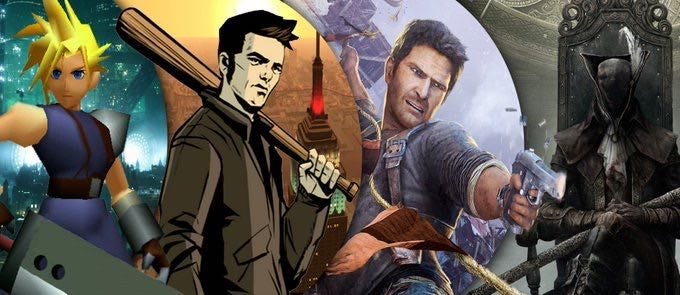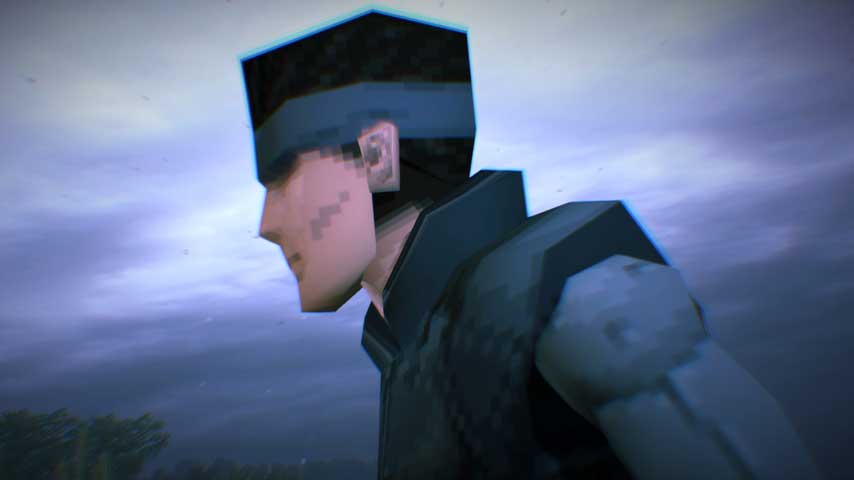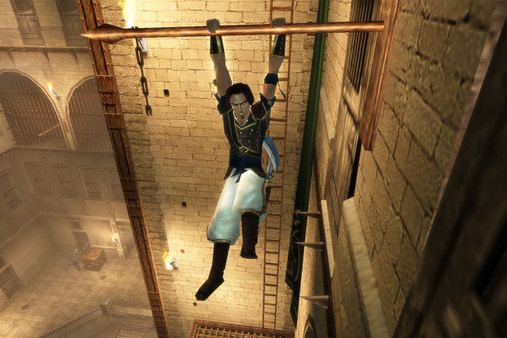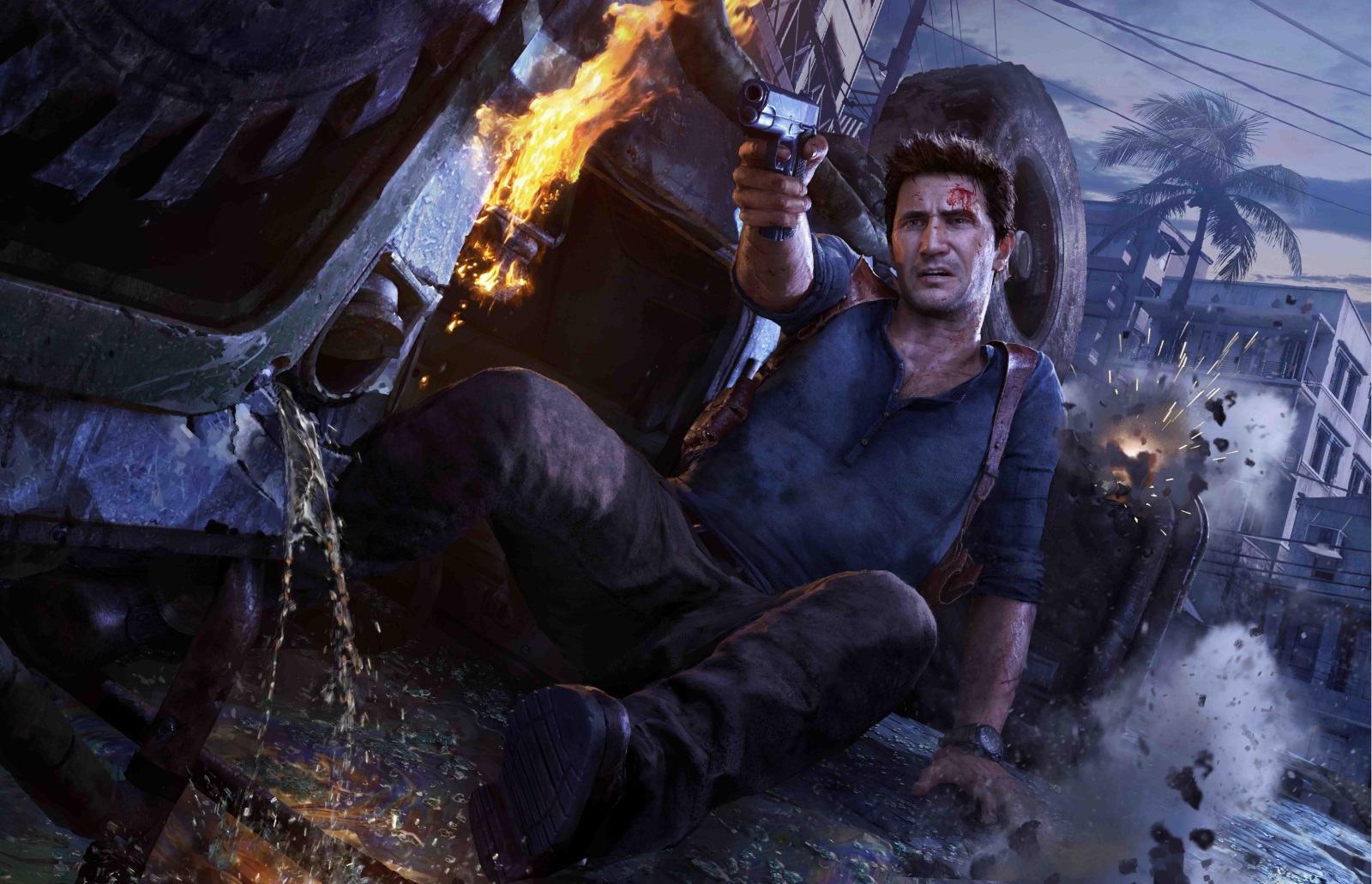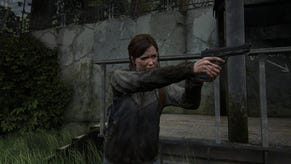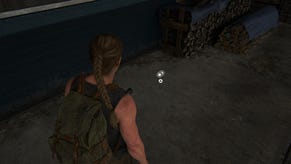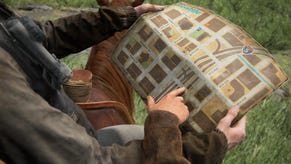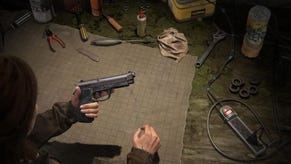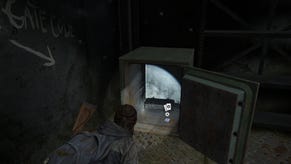The 25 games that defined 25 years of PlayStation
The PlayStation has been around for 25 years this week, and so we’re taking a look back at the games that defined the console over four generations.
PS1
Final Fantasy 7
“Somebody please get the guys who make cartridge games a cigarette and a blindfold.”
That, a print advertising slogan for Final Fantasy 7, says it all. Square’s epic was Sony’s secret weapon in the battle against Nintendo; a game so huge and so technically advanced that it wouldn’t be possible on cartridge-based hardware. The marketing implication that taking a bullet might be preferable to taking on FF7 would actually be fairly prophetic: it truly was the final nail in the N64’s coffin, as good as that system would go on to be.
Now, to be fair, any of the PS1 Final Fantasy titles could be on this list. All are excellent games, and all are somebody’s favourite. No single one of them is the best (or is there? It’s 9) - but FF7 is the game that not only defines its generation, but also launched the entire Japanese-made RPG subgenre into the stratosphere in the West. What was a niche genre was suddenly cool and enormous.
In the years since the PS1, Final Fantasy has meandered about in search of a new identity with varying degrees of success. In many ways, the shadow left by FF7 is so long that the series is still living in it - as evidenced in it being remade to the cost of many millions. It’s not just one of the best PlayStation games - it’s one of the most significant games of all time.
Suikoden 2
If there’s any JRPG that needs a remaster, it’s this tale of torn loyalty. Suikoden 2 blends JRPG combat with Fire Emblem-style strategy battles and intense one-on-one duels. It’s a story of heartbreak and betrayal, featuring a villain to rival even Sephiroth in the sinister Luca Blight. You also get to own a castle.
That castle is what makes Suikoden 2 so special. Over the course of the game, you build up your forces - hero characters who can command units in battle and even join you in turn-based fights. Some of them take up multiple character spots in the field because they are huge. Some are human, some are not - all have a completely different style, and each brings some new dynamic to your home base.
Recruit the chef and you unlock a brilliant cook-off minigame, where you battle it out to create the best three-course meal while being judged by a panel. It’s like Pokemon on a grander scale, where your Pokemon actually have character traits and backstories. While Final Fantasy 7 might hold its place as the most iconic PlayStation JRPG, Suikoden 2 is still one of the strangest and best, even today.
Tony Hawk’s Pro Skater 2
There's such a refined speed and flow to the movement of Tony Hawk's Pro Skater, coupled with the amount of tricks and tweaks the player can add, that it feels like a real extension of your will and imagination. I'd never felt anything as responsive at the time, so pliable and willing to explore if you can maintain that speed, grind that ledge and reach new heights.
Skating is about using the space around you in previously unintended ways, creatively appropriating something as dull and functional as a curb into fun. Developer Neversoft understood that there was never any need for a ridiculous mega ramp or loop, no fireworks. It just gives you a series of simple obstacles - bump to bar, crusty wall, a three-set of stairs - that can be endlessly linked through flexible finger tricks and the pressure of a two minute counter.
It also understood the need for authenticity, flooding the game with real skater-owned brands and a genuine soundtrack. To represent a true rebel activity you can't just pinch the bits a marketing exec thinks is cool - you have to support it and give something back. From the pro names to the urethane, THPS2 reflected the genuine culture of skateboarding, and helped propel it from the streets to the multimillion dollar entertainment and festival circuit. But even when you strip away its cultural significance, there's still an almost flawless, engaging, malleable video game underneath.
Metal Gear Solid
Metal Gear Solid released in the days before most people had access to the internet, and I still remember reading about it for the first time in the Official PlayStation Magazine as a kid. It sounded like nothing I’d ever played, beyond the things I even thought possible in video games. You can hide in a cardboard box, stow yourself away in the back of a truck, and be transported to another area? At the time, that blew my mind.
Enemies in games had always felt a bit mindless before Kojima’s stealth opus, but here they would hunt you down, follow your footprints in the snow, and even search underneath vehicles to flush you out. Beyond those solid fundamentals, it was the game’s inherent weirdness that made it stand out. Psycho Mantis reading your memory card and forcing you to switch controller ports will always be one of the most memorable moments in video games.
Resident Evil
Well before the days of good acting standards in video games, Jill Valentine farted out the iconic line, “Watch out, it’s a monster” to Big Barry Burton.
Despite its hamminess, though, Resident Evil still managed to scare the p**s out of everyone. That moment when you first see a zombie gorging on someone’s flesh. Those f**king dogs. Even the birds were pricks. These days we’ve settled into a standard control scheme for the majority of games, but OG Resident Evil wasn’t afraid of making you plant your feet to fire, using tank controls to emphasise the terror, forcing you to commit to every shot.
Its clever use of camera angles is also something we’ve moved away from - using fixed framing to draw the player’s eye to a spot before sending a mutated hound crashing through the window to give chase as your character disappears into the background. We got a remaster of this on PS4, keeping it exactly as it was while making it look prettier, and it still holds up today.
Silent Hill
Silent Hill was the first time I had ever been shocked by a game. I must have been about 12 years old, stoving in the heads of undead children with a drainpipe. The limitations of the hardware dictated heavy use of fog, which only compounded the foreboding atmosphere of Silent Hill. Resident Evil might have more memorable moments, but Silent Hill was the scarier game of the two by far.
Where Resident Evil focused on jump scares, Silent Hill was far more interested in psychological terror - watching the world fall away, walls replaced with chain-link fences as an air raid sirens blare out. The polygonal graphics also lent themselves to the setting, with humanoid shapes appearing in the geometry and daring you to press on.
Where Resident Evil casts you as well-armed special forces, Silent Hill has you play as a normal man, scared and out of his depth. The controls and weapon handling reflected this, getting across the sheer panic of his plight. You’re always left questioning what is real and what isn’t, its plot dislocated and contradictory. If you haven’t played it for a while, the details might be foggy, but you’ll always remember the fear.
Gran Turismo
“It looks real!” - me, an idiot, pointing at the boxy cars of Gran Turismo.
While we might be spoiled by endless polygons in 2019, there’s no denying how mindblowing this was at the time. Not only did it look amazing, but it had such a laser-focus on what it wanted to be: a proper racing sim with believable physics and accurately-modelled handling systems.
Most of my memories of Gran Turismo come from using it as something to show off the power of PlayStation. Well, that and trying to complete all those bastard-hard licence tests. It took five years of painstaking development for the dream of Gran Turismo to be realised - an almost unheard of amount of time for back then - but Sony was rewarded with the best selling PlayStation title of all time. Look up “mass appeal” in the dictionary and there’s a photo of a boxy Ford braking hard.
Crash Bandicoot
Naughty Dog back when they made games about naughty dogs - well, bandicoots, whatever they are. Crash was PlayStation’s attempt at creating a recognisable mascot for its platform, and it worked. Playing it now, it’s an incredibly frustrating experience, asking you to make pixel-perfect jumps while controlling Crash from awkward angles. Back then, we didn’t know any better, but that doesn’t make it any less iconic.
You can’t deny the influence. Without Crash ever running towards the screen, away from the huge boulder chasing him, we would have never seen Nathan Drake legging it from an armoured jeep. There have been plenty of failed attempts at creating iconic, recognisable characters in video games, but Crash has stood the test of time as a true Sony mascot.
Tekken
Perhaps fittingly for one of the games best known for eye-popping revelations about the PlayStation’s 3D-pushing hardware, Tekken actually didn’t begin development as a fighting game. It was actually a test software, designed to help Namco developers to figure out things like 3D animation and texture mapping. When ex-Sega staff who’d happened to work on Virtua Fighter defected to Namco, Tekken as we know it was born.
That is sort of the point, however. What Tekken did had been done before by Virtua Fighter to a certain degree, but Tekken raised the bar. It was slicker and cooler, with ridiculous FMV cutscenes where people would get thrown off cliffs (and later, into volcanoes). It was also accessible in a way that Virtua Fighter wasn’t while maintaining the nerd credentials, like a comparatively blistering frame rate and level of texture detail. It was also something new for this kind of game: an arcade port that was actually superior to the original coin-operated release. It’s no surprise that it became so legendary - it has it all.
Tomb Raider
Just like Crash Bandicoot, Nathan Drake probably never would have existed without Lara Croft. I remember being obsessed with Tomb Raider when I was playing through it for the first time, its angular geometry-based agility puzzles seared into my mind, to the point where I’d sketch out my own tombs on paper and trace a route through them. The dual pistols, the disdain for every living creature, and that feeling of exploration - all of it came together to create something that felt unlike anything else.
It was really unforgiving, too, like most games back then. Where adventure games these days automate much of the clambering, here it was like playing Twister with your fingers. You had to hold a button to sprint, release it at the perfect time, and hold another button to hang from the ledge you’re jumping towards. While it was a lot, it made every jump have actual stakes, rather than the fake peril of most modern games.
Wipeout 2097
One of the most memorable things about Wipeout and its sequel Wipeout 2097 was its advertising campaign, which featured pictures of people bleeding from the nose with glassy-eyed, thousand-mile stares, controller still in hand. The message was that this was the power of this high-speed racing game - that it was so real that you’d actually feel the G-forces until the blood vessels in your nose burst and your mind is addled. That’s marketing hyperbole, obviously - but in the mid nineties, Wipeout did indeed feel like a revelation.
Its thumping electronica soundtrack combined with the stylish futuristic trappings of the game’s visual design to make a clear announcement: this, and the console it appears on, is for grown-ups. Compared to its most prominent influence, Super Mario Kart, it offers a completely different style of experience - and that was very much the point. In this, it was a game that was emblematic of everything Sony’s PS1 stood for.
PS2
Grand Theft Auto 3
As with Final Fantasy 7 back on the PS1, everybody has a favourite of the GTA PS2 trilogy, and there will inevitably be some people who are angry to see the more ‘vanilla’ Grand Theft Auto 3 on this list as opposed to its more deeply themed and intricate follow-ups, Vice City and San Andreas. Let’s be fair - all three are excellent - but GTA 3 is a monolithic achievement that had an incredible impact on the whole industry.
GTA 3 stands as one of the early games that proved what sorts of worlds and experiences could be delivered in 3D, with this new, hyper-powerful hardware. Its open-world structure ended up defining the future. Its cast borrowed from Goodfellas (Frank Vincent, Debi Mazar), Twin Peaks (Kyle MacLachlan), The Matrix (Joe Pantoliano) and Reservoir Dogs (Michael Madsen), also predicted the industry’s star-studded future.
But, more than anything, GTA 3 is also just brilliant. Liberty City may not be as impressive as modern open worlds, but it’s a thriving, exciting place to explore and cause mayhem in - and it helped to set the bar for what players could expect from the PS2 hardware.
Shadow of the Colossus
Melancholic, thoughtful, lean - there aren’t many games as focused and sure of themselves as Shadow of the Colossus. On paper, it’s a boss rush game. The spaces between these bosses don’t really matter, with their sparse platforming and horse-saddled exploration. But it’s in those spaces where Shadow of the Colossus plays its cleverest hand: giving you time to think.
Each boss is a puzzle you have to solve, finding the right pattern to climb up the beast. When you finally do it and you plunge your dagger into their soft spots, there’s no fanfare - they just drop down dead. You’re doing this to bring a loved one back from the dead. An ancient power is whispering in your ear. You know it’s wrong, but you have no choice but to press on. It’s in those moments of quiet reflection between kills when you unpack the themes, and there’s no need for a three hour cutscene or endless exposition. Just you, your horse, and the wind.
Resident Evil 4
While the first Resident Evil established survival horror, it was Resident Evil 4 that reinvented it. If you measure the two games side-by-side, Resident Evil 4 has had the biggest impact. Taking the series from its fixed camera to an over-the-shoulder view could well have undermined the series, but it simply added a new element to the action.
Here much of the screen is blocked by protagonist Leon, so you have to shuffle and scan areas as you enter them. It makes the whole thing feel more claustrophobic. You still have to plant your feet and pick your shots, but now there could be something behind you that you can’t see.
The over-the-shoulder, laser pointer aiming added a new dynamic, too. In previous games, you only had to consider shooting, or letting them get close and aiming up to go for the head. Resident Evil 4 made aiming matter. The mutating villagers you face often sprout terrifying tendrils from their heads when they burst, so it’s often a case of weighing up your odds.
A quick knee shot and finishing them off with your knife to preserve ammo quickly becomes your go-to tactic and you settle into a routine. Then the game throws you a curveball and locks you into a siege, forcing you to block windows and keep the baying crowd at bay. These days we rarely see such a radical reinvention of an established series, but Resident Evil 4 will always be proof of how well one such transformation can work.
Prince of Persia: The Sands of Time
Prince of Persia is one of the first games I played where I actually thought, “Wow, video game acting can be really good.” It’s a story of a growing bond, of two people with real chemistry, who come together only to be cruelly torn apart. It’s bittersweet in a way many games don’t get anywhere near, even today.
Then there’s the gameplay - an attempt to solve the frustration of long load times between platforming deaths. In Sands of Time you could wall-run, bound, and take leaps of faith freely, so long as you still had sand in your dagger.
The ability to rewind time when you mess up had never been done before and it was perfect for a game like this. The way it was integrated into the story was just perfect, and that’s likely why it was never adopted as a standard mechanic for games like it. Look to racers, though, and you’ll see plenty of examples - there’s no need for narrative justification when you’re tearing a car around a track.
PS3
Journey
There’s something magical and irreproducible about Journey. At its most basic, it’s a game about holding forward on a stick. You wander through vast deserts and slide down golden dunes, all while heading towards your final destination - the peak of a snow-topped mountain. Like the name says, it’s a journey.
Part of its charm is how you piece together the point of this pilgrimage as you go, attempting to parse alien hieroglyphs and understand the meaning behind abandoned temples, graves, and shrines. Throughout your journey you can meet other players attempting the same trek, sharing a wordless walk together and communicating in whale-like coos.
Players who find all of Journey’s secrets get access to a special white robe, and many of them spend their time directing new players to the game’s secrets, passing their knowledge on without a whisper. There really is nothing like it.
Red Dead Redemption
Westerns have waned in popularity in modern media, so Red Dead Redemption could have been a big risk for Rockstar in a world obsessed with contemporary thrills. Yet, in transporting its open world expertise into this setting, the developer landed another commercial and critical hit - a game that constantly graces ‘best of’ lists the world over. Even now, despite its success, nobody has tried to ape it - the bar is just set too high.
Before Red Dead Redemption, Rockstar had been leaning on Hollywood as a hook for its games. Yes, Red Dead is reverent of the spaghetti Western, but it doesn’t rely on Hollywood talent to make its characters work. Instead it broke new talent, the game’s casting department perfectly capturing the characters with new voices, all bringing something fresh to the experience. It’s an epic tale that stays with you long after the sun sets on New Austin.
Demon’s Souls
Before Dark Souls, Bloodborne and Sekiro, Demon’s Souls was quietly carving a niche for itself. In those days, the belief was that the general games audience wasn’t interested in the challenging, sometimes frustrating experience FromSoftware was offering.
Slowly but surely, the game changed the minds of players and game executives alike, proving that it can sometimes be good to go against the grain. What started out as a game publishers didn’t even want to bring to the West has now established its own sub-genre and spawned dozens of pretenders.
FromSoftware’s unique formula resonated so well, in fact, the developer had to reinvent it twice since. Many will likely remember Dark Souls as the one that made the bigger splash, but none of that would have been possible if it weren’t for Demon’s.
Uncharted 2
The years are never kind to the types of scripted, set piece-heavy action games Naughty Dog has been known for. Uncharted 2 is not an exception to this rule, but it is the game that proved traditional cinematic stories can merge well with an interactive medium.
Whether they’ll admit it or not, Uncharted 2 is the game many rushed to show to their non-gamer friends to demonstrate what video games can do. It can be challenging for non-gamers to recognise some of the leaps video game storytelling has made up to that point.
Nothing, however, will turn heads quite the way a bombastic action movie in video game form like Uncharted 2 could. So much of what it made possible is dated today, but Uncharted 2 deserves credit for being a pioneer that brought to video games many fans who otherwise would shrug the medium off.
The Last of Us
You know a game is special when the title screen can make you feel. A curtain flapping in the wind is all it takes to get me excited about playing this masterful work of fiction just one more time. The Last of Us doesn’t contain a single bad moment, and it’s enhanced even further with Left Behind, an expansion that experiments with the mechanics and fleshes out a character you didn’t even know needed it.
One of The Last of Us’s greatest strengths is in its subtlety. I’m not talking about sneaking up on a clicker and plunging a shiv into its neck - I mean in those moments where characters share a look and it says more than entire cutscenes in a lot of other games. It felt like Naughty Dog coming of age, proving it can tackle serious subject matters with grace and thought. It’s a game that will always be synonymous with PlayStation - a true modern classic.
PS4
Bloodborne
It is exceedingly rare that a game can execute so well on a vision its makers set before a single line of code was written. Bloodborne is as close to a perfect representation of that as it gets. It simultaneously upends FromSoftware’s brilliant formula, creates a new style of action game, and does its Lovecraftian themes justice in a way never before seen.
Bloodborne is a peerless action masterpiece, an unsettling horror adventure, and a grim tale about the pursuit of and the curse of knowledge. Above all, it’s a statement of intent on the part of its developers that only they can innovate in the sub-genre it created.
Bloodborne may not have had the impact of Dark Souls, or the cult following of Demon’s Souls, but it is the one most people should play. It’s worth buying a PS4 for.
God of War
An argument could be made for the original God of War games making their way onto this list, but we’ve opted for the latest because it’s proof that developers can and should take risks. There was a good chance this could have alienated the fanbase. Kratos has always been rash, violent, and almost inhuman. Here Sony Santa Monica made Kratos care, made him introspective, forcing him to look back on the damage his vengeance caused and see how that violence can trickle down into future generations.
Art is at its most powerful when it is a reflection of the artist. This isn’t always possible in games, with them being collaborative projects between hundreds of people. But here, with a clear vision from creative director Cory Barlog, who had just become a father himself, we see a studio looking back on its own impact, how it wants to go into the future, and weaving that masterfully into the game itself.
Horizon: Zero Dawn
I’ve never been a big fan of the Killzone series so my expectations were tempered when I played Horizon: Zero Dawn for the first time. Could the team behind a linear, uber serious FPS really capture the essence of a living, dynamic world on their first try? The answer to my question, as I’m sure you know by now, is yes. Yes they could.
In fact, Horizon: Zero Dawn is one of the best new IPs to come out of this entire generation. Imagine a world where technology has advanced to the point where people became afraid of it and reverted back to the old ways, Horizon: Zero Dawn casts you as a curious, plucky explorer who can take out robotic dinosaurs with a bow and arrow. While Horizon borrows from a variety of other games, it still manages to feel like its own thing. It’s still one of the most beautiful games on PS4 as well.
Uncharted 4
An argument could be made about whether or not Uncharted 4 was necessary at all, but I’m glad it exists. It’s larger and more ambitious than what came before, allowing you to actually explore its hub areas instead of constantly pulling you along like Uncharted 3 does. This new freedom gives Uncharted 4 a fresh dynamic, whether you’re winching your jeep up a muddy hill or searching behind the mouth of a waterfall for secrets. This more open approach doesn’t take away from the action either, with one highlight being a Bad Boys 2-esque car chase down through a slum.
While the series could have easily ended with Uncharted 3, Uncharted 4 feels like a game for the hardcore Nathan Drake fans. It’s him finally growing up, realising how selfish he’s been. It’s a playable midlife crisis, where we’re free to pick through the past and turn over those historical glories in our hands. It’s a museum for Nathan Drake. The only thing that holds it back a little is how it pulls its punches - with some of that signature Naughty Dog heartbreak, it could have been an all-time classic.
